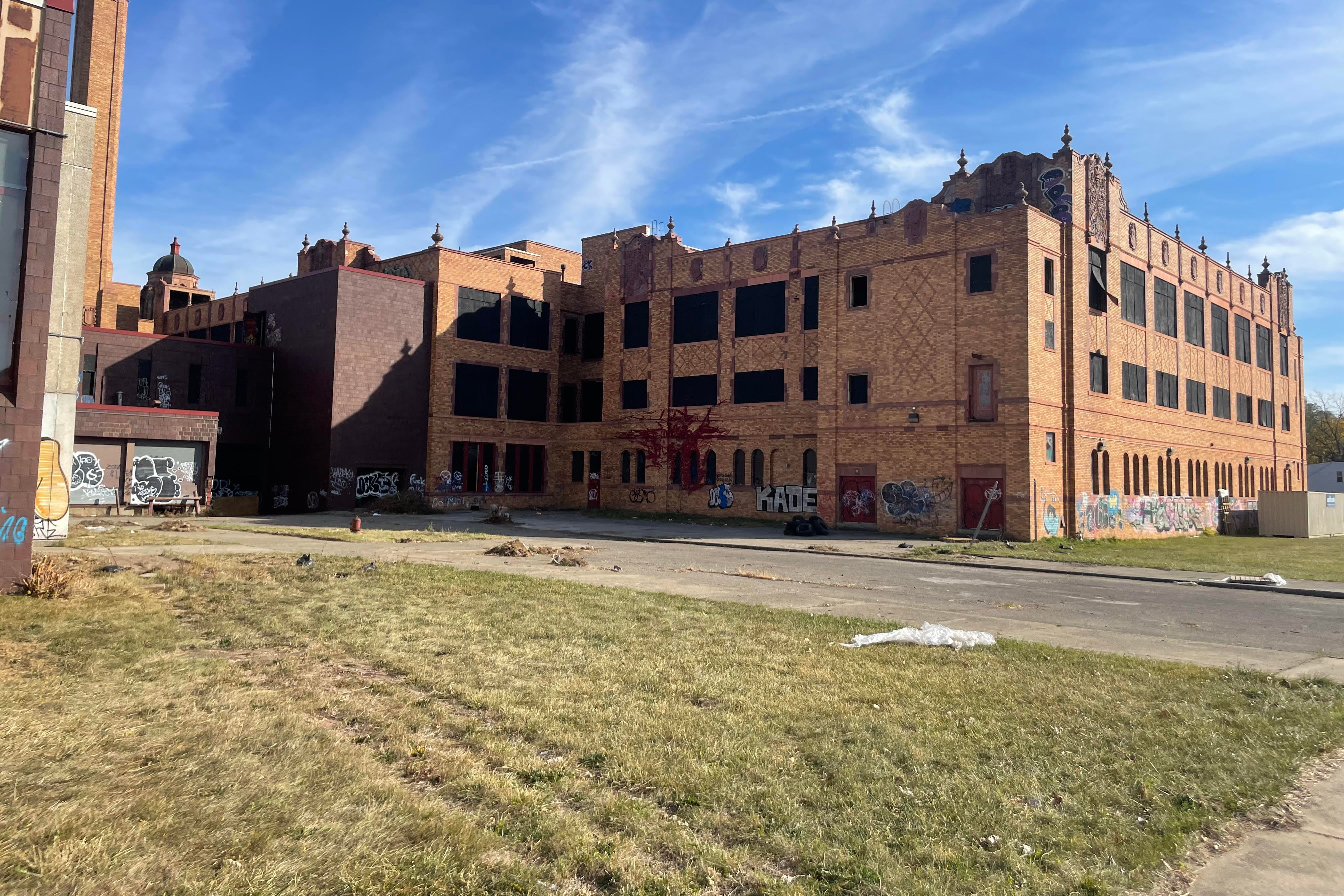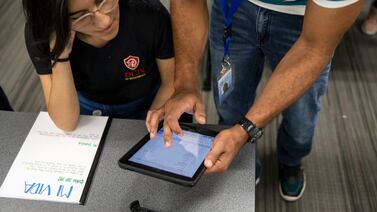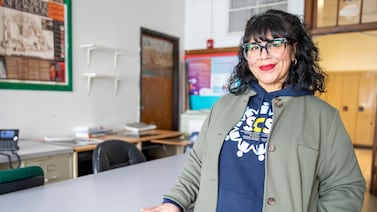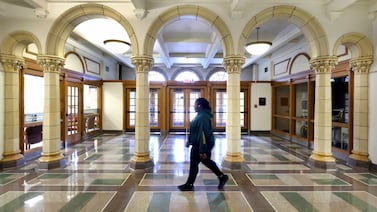Sign up for Chalkbeat Detroit’s free newsletter to keep up with the city’s public school system and Michigan education policy.
After years of little progress, two facility projects for Detroit Public Schools Community District are moving forward.
The district’s philanthropic arm, the DPSCD Foundation, plans to invest more than $32 million in two capital projects, which include redeveloping the vacant Cooley High School into a district and community-based sports facility and relocating Davis Aerospace Technical High School back to the Coleman A. Young International Airport, according to a news release.
The Cooley sports complex would include a football field, an outdoor track, and community and green space and is expected to be completed by 2026.
The announcement was made at the district’s annual Hall of Fame Alumni Gala May 3.
The news comes after development plans in recent years stalled for both schools. In 2023, DPSCD rejected nonprofit Life Remodeled’s proposal to turn Cooley, which closed in 2010, into a community hub. The organization, which aims to revitalize neighborhoods with the help and cooperation of neighborhood organizations, was planning to house various nonprofits at Cooley, including a pediatric mental health center, vocational college, and after-school programs.
Life Remodeled made two offers to the district: $1 million in cash, which included the school’s 5.7 acres of athletic property, and $500,000 in cash, with the assurance of an eventual $1 million donation to DPSCD, should it wish to build an athletic complex on its own, former CEO Chris Lambert wrote in a letter at the time to area residents, Cooley alumni, and community partners. The district rejected both proposals.
DPSCD Superintendent Nikolai Vitti said the Life Remodeled proposal raised concerns among some board members over whether the district was underpricing the property, and how future owners would use the site, specifically a football field that was to be gifted to a junior college. Vitti at the time noted that plans for the field weren’t explicitly stated in the proposal.
Life Remodeled CEO Diallo Smith said in a statement that the organization has a strong partnership with DPSCD and they are excited for the students and the residents who will benefit from the new sports complex.
“Although we weren’t able to fulfill our vision for the Cooley property, we’ve continued to execute our mission of creating neighborhood revitalization that lasts through our opportunity hubs,” he said. “We take pride in what we’ve been able to accomplish with the central Detroit community at the Durfee Innovation Society, and we look forward to extending that impact with our eastside hub, Anchor Detroit, opening in 2026.”
Meanwhile, moving Davis Aerospace back to City Airport has been a goal for DPSCD since the district announced its facility master plan in 2022. But inadequate funding has been the main factor in the plan’s delay. Last year, Vitti told BridgeDetroit that the district was looking to privately raise $9.6 million with support from the DPSCD Foundation or to obtain a one-time earmark from the state budget. Costs to relocate Davis Aerospace to the airport include converting one of the terminals into a school building.
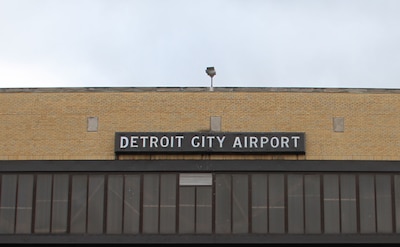
“The school board and I are fully committed to making the relocation happen,” Vitti told BridgeDetroit in 2023. “So if private funding or separate state funding is not provided, then we will prioritize this commitment in future district budgets.”
Opening in 1986, Davis Aerospace relocated from City Airport to Golightly Career and Technical Center in 2013 while the district was under state-appointed emergency manager Roy Roberts. Without access to the airport, the school could no longer help students obtain the federal certification in aviation mechanics that would give them an inside track to steady, high-paying jobs.
Davis Aerospace is the only school of its kind in Detroit and one of few aerospace-focused schools in Michigan.
Here’s what the projects will look like
With the support of the DPSCD Foundation, the new school building for Davis Aerospace will now be funded by a $7 million appropriation from the State of Michigan, alongside district funding. The project is expected to be completed by 2027.
The move back to City Airport will expand the aviation and engineering curriculum to include hands-on training and double the school’s enrollment to 200 students, stated the news release.
“We are incredibly excited for Davis Aerospace to return to its original home where students will have direct access to airplanes as part of their training,” Vitti said in the news release. “This program has a long history of opening the door to lucrative career opportunities for students, including six-figure aviation jobs. With this move, we are returning the school to its roots where students can learn about flying and maintaining planes in the most appropriate setting.”
Brian Smith, president of the Tuskegee Airmen National Historical Museum, said he’s excited the school is moving back to the airport. His organization, which hosts various programs and classes for children, teens, and young adults, has been helping to fill a void for areas the school doesn’t have the capacity to teach, such as a flight academy and a full maintenance program.
Smith said that Davis Aerospace gives young people in Detroit a pathway to the middle class by educating them about an industry that doesn’t always require a college degree.
“These are six-figure jobs that you wouldn’t get in the normal careers that students go into,” he said.
While the Tuskegee Museum has a partnership with DPSCD, Smith hopes to work specifically with Davis Aerospace in the future.
“We’ve been working as though we are partners; getting the elementary school students knowledgeable about careers in aviation and giving them some aviation experience with free airplane rides, with classes that we do in school or here at the airport, just to get their minds wrapped around the concept of, ‘I can have a career without actually going to college.’ We are very open to a formal partnership with Davis Aerospace,” he said.
For the Cooley project, DPSCD will use $15 million from the state, which will support the planning, design, and construction for the outdoor football field track as well as the green space and updated parking lots. The DPSCD Foundation will raise the remaining $10 million.
Plans include preserving a part of the building for a locker room, weight room, community gathering space, and dedication to Cooley alumni, according to the news release. Long-term plans possibly include two buildings, one for multiple basketball and volleyball courts and another for an indoor football, track, lacrosse, and soccer field.
Located at 15055 Hubbell Ave., Cooley opened in 1928 and became one of Detroit’s most storied high schools, revered for its athletic programs as well as its Mediterranean Revival architectural style. The former high school is one of the largest empty public schools in Detroit, according to city documents. The 302,600-square-foot building is more than twice the size of the Charles H. Wright Museum of African American History.
In 2011, the school building was listed under the National Register of Historic Places.
“Ever since Cooley High School closed in 2010, the community has wanted us to do something special with this legendary site,” Vitti said in the release. “We are laser-focused on honoring this commitment with an exciting new complex that builds on Cooley’s legacy and creates equitable sports opportunities for Detroit student athletes and the community.”
Micah Walker is a reporter for BridgeDetroit. You can reach her at mwalker@bridgedetroit.com.

